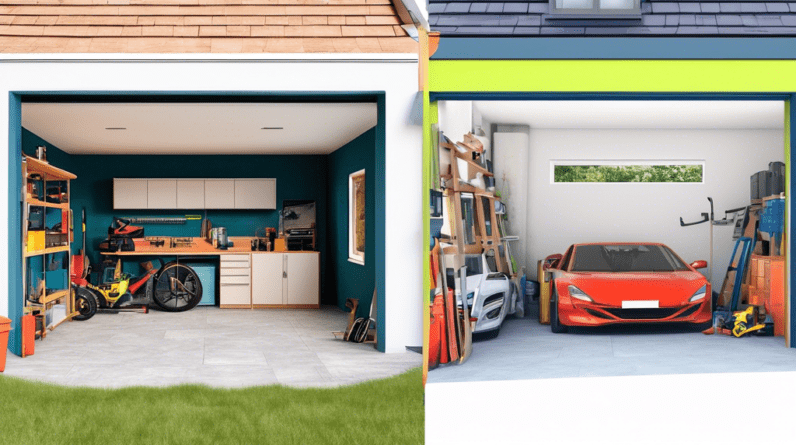
Introduction
Converting your garage can be a fantastic way to add more living space to your home without the upheaval and cost of moving. Whether you’re dreaming of a spacious home office, a cozy guest suite, or a state-of-the-art entertainment room, a well-planned garage conversion can transform this underutilized area into a valuable extension of your living space.
However, embarking on a garage conversion is a significant financial undertaking. Before you start picking out paint colors and flooring, it’s crucial to establish a realistic budget that encompasses all aspects of the project. Proper budgeting is essential to avoid unpleasant surprises and ensure your dream conversion becomes a reality without breaking the bank.
Why Create a Budget for Your Garage Conversion?
Creating a comprehensive budget is the cornerstone of any successful garage conversion project. It offers a roadmap for your finances, helping you:
- Set Realistic Expectations: A detailed budget provides a clear picture of the potential costs involved, allowing you to set achievable goals and avoid overspending.
- Make Informed Decisions: When you have a budget in place, you can make well-informed decisions about materials, finishes, and labor, ensuring you stay within your financial limits.
- Secure Financing: If you plan to finance your garage conversion, having a detailed budget is essential to secure a loan with favorable terms.
- Track Your Spending: A well-structured budget allows you to track your expenses throughout the project, enabling you to identify potential overruns early on and make necessary adjustments.
- Minimize Financial Stress: Knowing you have a financial plan in place provides peace of mind and reduces the risk of encountering unexpected costs that could derail your project.
Factors Influencing Garage Conversion Costs
The cost of converting your garage can vary significantly depending on several factors, including:
1. Size and Scope of the Project
The size of your garage and the complexity of the conversion will have a substantial impact on the overall cost.
- Small Conversions: Basic conversions, such as transforming a garage into a home office or gym, typically involve fewer structural changes and lower material costs.
- Large Conversions: More extensive projects, like creating a guest suite or living area, may require adding plumbing, insulation, heating, and potentially altering the roofline, significantly increasing expenses.
2. Location and Local Regulations
Building costs and regulations can differ considerably depending on where you live.
- High-Cost Areas: Urban areas and regions with a high cost of living generally have higher labor and material costs.
- Permits and Inspections: Obtaining the necessary permits and inspections from your local authorities will also factor into your budget.
3. Existing Condition of Your Garage
The current state of your garage will play a role in determining the extent of work required.
- Foundation and Structure: If your garage has foundation issues, structural damage, or inadequate insulation, addressing these problems will add to the overall project cost.
- Electrical and Plumbing: The availability of existing electrical wiring and plumbing connections can impact the cost of extending these services to your converted space.
4. Quality of Materials and Finishes
The choices you make regarding materials and finishes will significantly influence the overall budget.
- Budget-Friendly Options: Selecting basic materials and finishes for flooring, countertops, cabinets, and fixtures can help keep costs down.
- High-End Finishes: Opting for premium materials and custom features will naturally increase your expenses.
5. Labor Costs
Labor is a significant expense in any garage conversion project, and rates can vary depending on your location and the complexity of the work.
- General Contractors: Hiring a general contractor to manage the project, subcontractors, and permits is a common approach.
- DIY Approach: If you have the skills and experience, taking on some of the work yourself can potentially save on labor costs but requires careful planning and execution.
Creating a Detailed Budget for Your Garage Conversion
Now that you understand the key factors influencing costs, let’s outline the steps involved in creating a comprehensive budget:
1. Define Your Vision and Scope
- Purpose of the Conversion: Clearly define how you intend to use the converted space (e.g., home office, guest room, entertainment area).
- Desired Features: List the essential features and amenities you want to include (e.g., bathroom, kitchenette, built-in storage).
- Level of Finish: Determine the desired level of finish, from basic and functional to high-end and luxurious.
2. Research and Gather Information
- Local Building Codes: Contact your local building department to inquire about specific regulations and permit requirements for garage conversions in your area.
- Material Costs: Visit local home improvement stores and suppliers to get an idea of material costs for flooring, insulation, drywall, windows, doors, fixtures, and other necessary supplies.
- Labor Rates: Request quotes from reputable contractors and subcontractors in your area to gauge average labor costs for different aspects of the project.
3. Break Down the Costs
Divide your budget into specific categories to ensure you account for all potential expenses. Here’s a detailed breakdown of typical cost categories:
a) Design Fees (5%-15% of Total Budget)
- Architectural Plans: If your conversion involves structural changes or significant modifications, hiring an architect to draw up plans is essential.
- Engineering Services: For more complex projects, you may need structural engineers to assess load-bearing walls and ensure the foundation can handle the added weight.
- Interior Design: Consider consulting an interior designer for assistance with space planning, material selection, and creating a cohesive aesthetic.
b) Permits and Inspections (Variable but Budget Around $500-$2,000)
- Building Permits: Most garage conversions require building permits, ensuring the work complies with local building codes.
- Electrical and Plumbing Permits: If your project involves adding or modifying electrical wiring or plumbing, separate permits will likely be necessary.
- Inspection Fees: Factor in fees for inspections throughout the project to ensure the work meets code requirements.
c) Demolition and Site Preparation (5%-10% of Total Budget)
- Demolition: This phase may involve removing existing walls, flooring, and fixtures to prepare for the conversion.
- Waste Removal: Budget for the proper disposal of construction debris and unwanted materials.
- Site Protection: Taking measures to protect your home from dust and debris during construction is crucial.
d) Foundation and Framing (10%-20% of Total Budget)
- Foundation Repair or Reinforcement: Addressing any existing foundation problems or strengthening it for the added weight of living space is essential.
- Framing: Building new walls, doorways, and potentially raising the ceiling height are common framing tasks.
- Insulation: Properly insulating the walls, ceiling, and floor is crucial for energy efficiency and comfort.
e) Roofing (5%-10% of Total Budget, If Applicable)
- Roof Extensions: If your conversion alters the roofline, extending the roof and ensuring proper flashing and sealing is necessary.
- Roof Repairs: While the roof is accessible, addressing any existing repairs or leaks is advisable.
f) Electrical and Plumbing (10%-15% of Total Budget)
- Electrical Wiring: Extending or upgrading electrical service to accommodate outlets, lighting, and appliances is essential.
- Plumbing: If adding a bathroom or kitchenette, installing new plumbing lines for water supply and drainage is necessary.
- HVAC: Extending or modifying your heating, ventilation, and air conditioning system to ensure the converted space is comfortable year-round.
g) Drywall, Painting, and Finishing (15%-20% of Total Budget)
- Drywall Installation: Installing drywall on the walls and ceiling creates a smooth surface for finishing.
- Painting: Painting the walls, ceiling, trim, and doors adds a fresh and finished look.
- Flooring: Choose from a variety of flooring options, such as hardwood, laminate, tile, or carpet, based on your preferences and budget.
h) Fixtures and Appliances (10%-15% of Total Budget)
- Lighting Fixtures: Selecting appropriate lighting for different areas of the converted space is crucial.
- Plumbing Fixtures: If adding a bathroom or kitchenette, choose sinks, faucets, toilets, and showerheads.
- Appliances: Budget for any appliances needed, such as a refrigerator, oven, dishwasher, or washer/dryer.
i) Windows and Doors (5%-10% of Total Budget)
- Windows: Adding windows to your converted garage brings in natural light and improves ventilation.
- Doors: Installing a new entry door and potentially interior doors to separate rooms within the space.
j) Landscaping and Exterior Finishes (5%-10% of Total Budget)
- Exterior Siding and Paint: Matching the exterior finish of your converted garage to the rest of your home is essential for curb appeal.
- Landscaping: Consider landscaping enhancements, such as planting trees, shrubs, or flowers, to blend the addition seamlessly into your yard.
k) Contingency Fund (5%-10% of Total Budget)
- Unexpected Issues: It’s crucial to set aside a contingency fund to cover unexpected issues or unforeseen costs that may arise during the project.
Tips for Staying on Budget
Once you’ve established a comprehensive budget, here are some practical tips to help you stay on track:
- Prioritize Your Spending: Identify your must-have features and amenities and prioritize them over less essential items. Be willing to compromise on certain aspects to stay within budget.
- Get Multiple Quotes: Don’t hesitate to solicit quotes from at least three different contractors and suppliers for each phase of your project to ensure you’re getting competitive prices.
- Shop Around for Materials: Compare prices for building materials, fixtures, and appliances from different vendors to find the best deals. Consider using reclaimed or salvaged materials for added character and cost savings.
- DIY When Possible: If you have the skills and experience, consider tackling some aspects of the project yourself to save on labor costs. However, be realistic about your abilities and don’t hesitate to hire professionals for tasks that require specialized knowledge.
- Monitor Your Spending Regularly: Keep a close eye on your expenses throughout the project, comparing them against your budget. Use spreadsheets, budgeting apps, or software to track your spending effectively.
- Communicate Openly with Your Contractor: Maintain clear and consistent communication with your contractor or project manager. Discuss any potential changes to the scope of work or material selections that could impact the budget.
- Be Prepared for Unexpected Costs: Even with meticulous planning, unforeseen issues can arise. Having a contingency fund in place provides a financial buffer to handle unexpected repairs, material price increases, or other unforeseen expenses.
Conclusion
Converting your garage into a functional and stylish living space is an exciting endeavor that can significantly enhance your home’s value and livability. By carefully planning, researching, and creating a detailed budget, you can embark on this transformative journey with confidence, knowing you’re financially prepared for the road ahead. Remember, a well-executed garage conversion starts with a solid budget, ensuring your dream transformation becomes a reality without breaking the bank.






